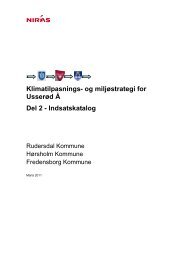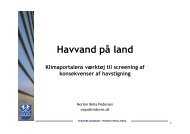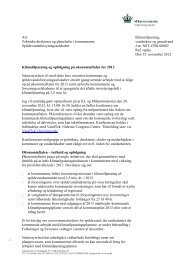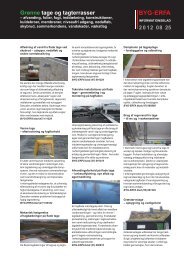Mapping climate change - barriers and opportunities for action
Mapping climate change - barriers and opportunities for action
Mapping climate change - barriers and opportunities for action
You also want an ePaper? Increase the reach of your titles
YUMPU automatically turns print PDFs into web optimized ePapers that Google loves.
the EU Floods Directive 3 , which sets out requirements e.g. <strong>for</strong> mapping of flooding risks <strong>and</strong><br />
preparation of risk management plans <strong>for</strong> flood-prone areas.<br />
Due to the special physical conditions that characterise the west coast of Jutl<strong>and</strong>, coastal protection<br />
is here maintained by state <strong>and</strong> municipal authorities.<br />
As a general rule, the establishment <strong>and</strong> operation of ports <strong>and</strong> fairways are the responsibility of the<br />
individual port. A few ports are partially or fully state-owned. The state is also responsible <strong>for</strong><br />
maintaining the minimum depth of main fairways <strong>and</strong> the entrances to some ports.<br />
Possibilities <strong>for</strong> adaptation<br />
Coastal protection of the central part of the west coast of Jutl<strong>and</strong> takes place chiefly by<br />
compensating <strong>for</strong> erosion through beach nourishment. In order to curb the effects of <strong>climate</strong> <strong>change</strong><br />
<strong>and</strong> also maintain the current, political ambition to keep the coastal development in check, beach<br />
nourishment ef<strong>for</strong>ts may be gradually increased. For other coasts, the significance of erosion should<br />
be assessed <strong>for</strong> the individual area. The increase in erosion due to <strong>climate</strong> <strong>change</strong> is currently<br />
progressing slowly. There is no immediate need <strong>for</strong> response, however, in the long run, it may be<br />
relevant to look at coastal protection <strong>and</strong> l<strong>and</strong>-use <strong>change</strong>. In other words, there are <strong>opportunities</strong><br />
<strong>for</strong> ongoing adaptation.<br />
For those parts of Denmark where dykes <strong>and</strong>/or dunes protect human lives, the appropriate response<br />
to the <strong>climate</strong>-<strong>change</strong> induced deterioration of dyke protection would be to <strong>for</strong>tify the dykes <strong>and</strong><br />
dunes to maintain the current level of protection. This would naturally include regular updating of<br />
the emergency <strong>and</strong> storm surge response plan in place.<br />
In connection with future maintenance work on port protection, it should be assessed whether the<br />
individual construction can withst<strong>and</strong> increasing loads. Furthermore, emergency preparedness in the<br />
event of storm alert should be adjusted regularly to prevent storm damage. Ferry l<strong>and</strong>ings should be<br />
modified regularly <strong>and</strong> fairways should be dredged more frequently as required.<br />
Initiatives completed <strong>and</strong> in progress<br />
In 2010 the Ministry of Transport published a <strong>climate</strong> <strong>change</strong> adaptation strategy. Following the<br />
publication, per<strong>for</strong>mance requirements <strong>for</strong> <strong>climate</strong> <strong>change</strong> adaptation were introduced in the 2012<br />
per<strong>for</strong>mance contracts of all major institutions under the Ministry. These per<strong>for</strong>mance requirements<br />
entail preparing an <strong>action</strong> plan <strong>for</strong> <strong>climate</strong> <strong>change</strong> adaptation with targets <strong>and</strong> a milestone plan, as<br />
well as a "declaration of services" concerning the availability of the transport infrastructure.<br />
In 2011, the Danish Coastal Authority published a national coastal protection strategy <strong>for</strong> the<br />
<strong>climate</strong> proofing of Danish coasts that is required in order to ensure sustainable use of the coasts in<br />
future. The coastal protection strategy aims at ensuring that coastal protection is approached<br />
holistically, taking into account the many stakeholders involved, as well as including coastal<br />
protection in a long-term perspective.<br />
In 2011, the Danish Coastal Authority held a coastal conference at which focus was on the future<br />
coastal l<strong>and</strong>scape, the national coastal protection strategy <strong>and</strong> implementation of the EU Floods<br />
3 The Danish Coastal Authority is responsible <strong>for</strong> implementing those parts of the EU Floods Directive that relate to coasts<br />
<strong>and</strong> fjords, while the Danish Nature Agency is responsible <strong>for</strong> implementing the parts that relate to watercourses <strong>and</strong> lakes.<br />
33

















